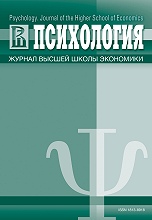The Experimental Study of the Visual Perception of Depth the Flat Images, Eye Movement Registration
Abstract
The experimental results on the ability of three-dimensional perception of planar images are presented. The objective of the research was to study the direction of eye movement when viewing various types of images. It was assumed that the perception of the depth of the planar image would have an effect on the eye movements. The research task consisted in comparing the level of perception of the depth of a planar image with the characteristics of eye movement when perceiving the stereoscopic depth of the stereogram and the depth of perception of a raster 3D-image. It is shown that the plane of the perceived image is located behind it at a distance of 8-58 cm in the conditions of three-dimensional perception. It is also shown that the plane of the perceived image on the 3D-raster is located at a distance of 23–37 cm behind the raster. The histogram of the difference shows that the perception of the depth, volume of the planar image and the depth of the raster image correspond to the same dependencies. A similar shape of the histogram was also registered with a planar perception of a stereogram. It is assumed that the histogram contour of the difference under conditions of its planar perception includes the relief effects. The presented experimental material shows that the effects of perception of the depth, the volume of a planar image, are characterized by at least one level of value with the stereoscopic depth of stereograms and 3D-raster image.
Downloads
References
2. Antipov, V. N., & Yakushev, R. S. (2011). Intuitivnyi eksperimental’no-fizicheskii podkhod v obrazovatel’nom proekte po razvitiyu intellektual’nykh sposobnostei cheloveka [Intuitive experimentalphysical approach in the educational project of development of human intellectual abilities]. Obrazovatel’nye Tekhnologii i Obshchestvo, 14(1), 400-406. (in Russian)
3. Antipov, V. N., & Zhegallo, A. V. (2012). Eksperimental’noe izuchenie 3D-vospriyatiya obrazov ploskostnykh izobrazhenii [Experimental studies of 3D perception of planar images]. In V. A. Barabanshchikov (Ed.), Eksperimental’nyi metod v structure psikhologicheskogo znaniya [Experimental method in the structure of psychological knowledge] (pp. 187-194). Moscow: Institute of Psychology of RAS. (inRussian)
4. Antipov, V. N., & Zhegallo, A. V. (2014).Three-dimensional perception of flat images in computerized environment. Eksperimental’naya Psikhologiya [Experimental Psychology (Russia)], 7(3), 97-111. (in Russian)
5. Gusev, A. N. (2007). Oshchushchenie i vospriyatie [Sensation and perception]. Moscow: Akademiya. (in Russian)
6. Julez, B. (1960). Binocular depth perception of computer-generated patterns. The Bell System Technical Journal, 39, 1125-1162.
7. Minzaripov, R. G., Antipov, V. N., Chitalin, N. A., Shaposhnikov, D. A., Baltina, T. V., Skobel’cina, E. G., & Yakushev, R. S. (2009). About application of three-dimensional creative-cognitive vision development method in innovative educational area. Uchenye Zapiski Kazanskogo Universiteta. Seriya Estestvennye Nauki, 151(3), 266-277. (in Russian)
8. Raushenbakh, B. V. (2001). Geometriya kartiny i zritel’noe vospriyatie [Geometry of a picture and visual perception]. Saint Petersburg: Azbuka-klassika. (in Russian)
9. Schiffman, H. R. (2003). Oshchushchenie i vospriyatie [Sensation and perception]. Saint Petersburg: Piter. (in Russian) (Trans. of: Schiffman, H. R. (2001). Sensation and perception: An integrated approach(5th ed.). New York: John Wiley & Sons.)
10. Tyler, C. (1983). Sensory processing of binocular disparity. In C. M. Schor & K. Ciuffreda (Eds.), Vergence eye movements: Basic and clinical aspects(pp. 199-295). Boston: Butterworth.
11. Tyler, C., & Clarke, M. (1990). The autostereogram. Proceedings of the SPIE, 1256, 182-197.
12. Valueva, E. A., & Ushakov, D. V. (2017). Insight and incubation in thinking: the role of awareness processes. Siberian Journal of Psychology, 63, 19-35. https://doi.org/10.17223/17267080/63/2 (in Russian)





